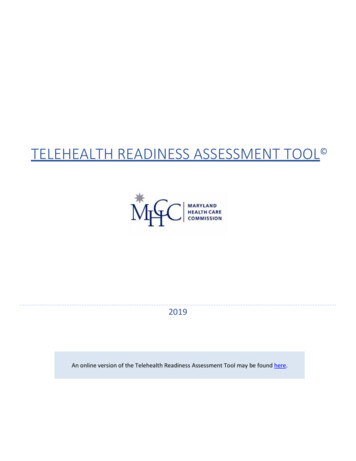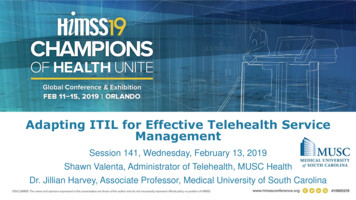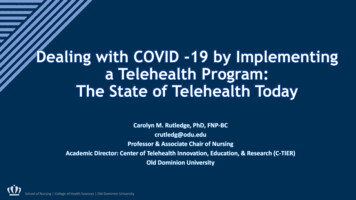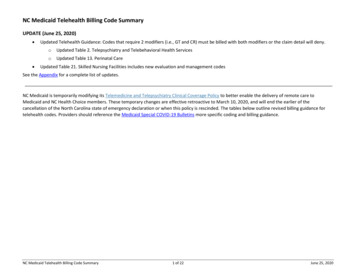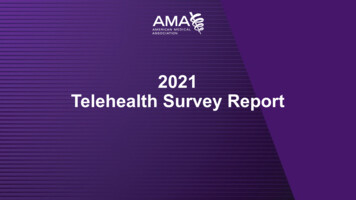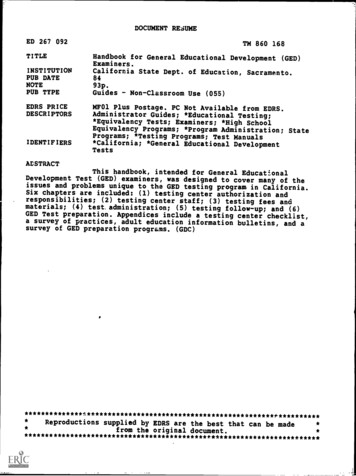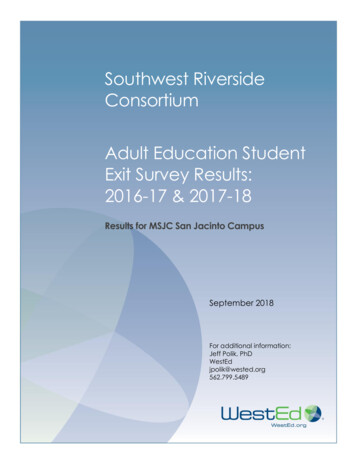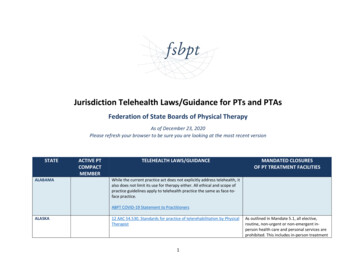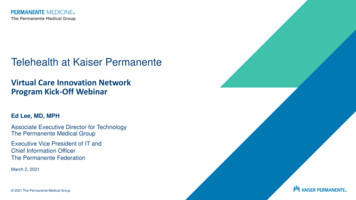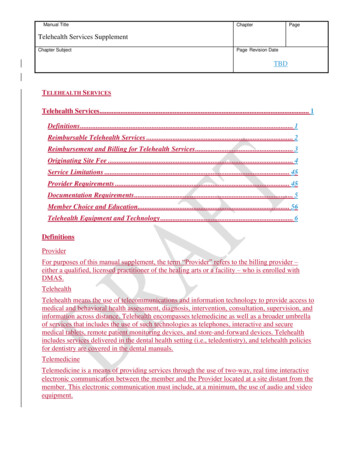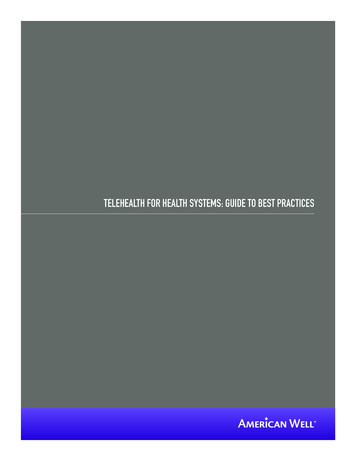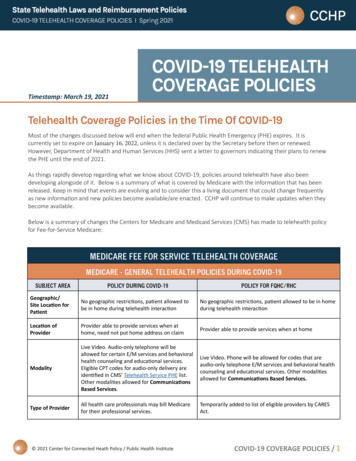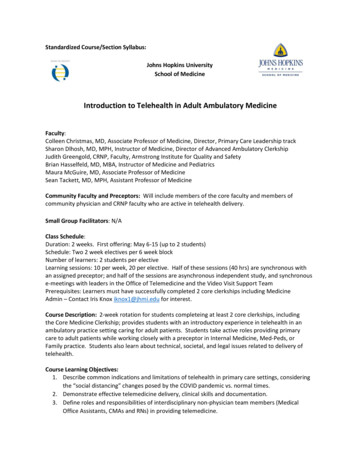
Transcription
Standardized Course/Section Syllabus:Johns Hopkins UniversitySchool of MedicineIntroduction to Telehealth in Adult Ambulatory MedicineFaculty:Colleen Christmas, MD, Associate Professor of Medicine, Director, Primary Care Leadership trackSharon Dlhosh, MD, MPH, Instructor of Medicine, Director of Advanced Ambulatory ClerkshipJudith Greengold, CRNP, Faculty, Armstrong Institute for Quality and SafetyBrian Hasselfeld, MD, MBA, Instructor of Medicine and PediatricsMaura McGuire, MD, Associate Professor of MedicineSean Tackett, MD, MPH, Assistant Professor of MedicineCommunity Faculty and Preceptors: Will include members of the core faculty and members ofcommunity physician and CRNP faculty who are active in telehealth delivery.Small Group Facilitators: N/AClass Schedule:Duration: 2 weeks. First offering: May 6-15 (up to 2 students)Schedule: Two 2 week electives per 6 week blockNumber of learners: 2 students per electiveLearning sessions: 10 per week, 20 per elective. Half of these sessions (40 hrs) are synchronous withan assigned preceptor; and half of the sessions are asynchronous independent study, and synchronouse-meetings with leaders in the Office of Telemedicine and the Video Visit Support TeamPrerequisites: Learners must have successfully completed 2 core clerkships including MedicineAdmin – Contact Iris Knox iknox1@jhmi.edu for interest.Course Description: 2-week rotation for students completeing at least 2 core clerkships, includingthe Core Medicine Clerkship; provides students with an introductory experience in telehealth in anambulatory practice setting caring for adult patients. Students take active roles providing primarycare to adult patients while working closely with a preceptor in Internal Medicine, Med-Peds, orFamily practice. Students also learn about technical, societal, and legal issues related to delivery oftelehealth.Course Learning Objectives:1. Describe common indications and limitations of telehealth in primary care settings, consideringthe “social distancing” changes posed by the COVID pandemic vs. normal times.2. Demonstrate effective telemedicine delivery, clinical skills and documentation.3. Define roles and responsibilities of interdisciplinary non-physician team members (MedicalOffice Assistants, CMAs and RNs) in providing telemedicine.
4. List common barriers to telemedicine related to faculty, community providers, technology, andpayer restrictions.5. Describe how telehealth may specifically affect quality, safety, disparities and outcomes relatedto social determinants of health.Objective1. DescribeSkills/KnowledgeDisaster-based telemedicineExpansion of resourcesEconomics of telemedicineLearning MethodAttend Office ofTelemedicinemeetingsInterview patientsand preceptors2. DemonstrateHow to prepare for a clinic sessionShared agenda setting with patientsEffective use of time in a clinic visitTelehealth exam fundamentalsPatient education and engagementWork withpreceptors tocompletetelehealth visitscommonindications and limitations oftelehealth in primary caresettingseffectivetelemedicine delivery, clinicalskills and documentation.3. Define roles andresponsibilities ofinterdisciplinary nonphysician team members(Medical Office Assistants &CMAs) in providingtelemedicine.4. List common barriers totelemedicine related to faculty,community providers,technology, and payerrestrictions.5. Describe how telehealth mayspecifically affect quality, safety,disparities and outcomes relatedto social determinants of nLearnerReflective writingPreceptorevaluationPatient Log35-40 hours over 2week electiveAssist one (1) twohour team-basedtraining; reviewcompetencychecklists, shadowVideo-VisitSupport ent access to devices and internetPatient privacy concernsUnderstand implications ofunreliable/ incomplete Hx & PEWork withpreceptorsMeetings withtelehealth leadersPreceptorevaluationDistinguish among patients whorequire a follow-up visit in weeks,days, or same-day hospital admissionPrioritize diagnostic testing orders,with attention to high value carebalanced with patient’scircumstancesEngage in shared decision-makingwith such patients to establish plansfor next steps-Patient Log-Journal Entry-Shadow VideoVisit SupportTeam (VVST)PreceptorevaluationReview team-based telemedicineworkflowsBuild skills in collaborativecommunication with members ofinter-professional teamPatient LogJournalBrief report onemergingtelemedicine topicIndependent Study Complete work on projects: QI / Patient Safety; High Value Care; Disease Prevention; Clinicalreflections; Emerging Telemedicine Telemedicine Clinical skills websiteMaterials:Office of Telemedicine Sharepoint epictraining/SitePages/Telemedicine.aspx
JHCP Telemedicine .htmlAssignmentsStudents will be assigned to a preceptor and meet virtually for 10 sessions. They will observe theworkflow of a Telehealth practice and listen in to the preceptor’s video visits at the start of theElective. As experience is gained, the student will first conduct visits synchronously while the preceptorobserves the entire visit, and later may initiate individual video visits, then give an oral presentation totheir preceptor who then joins the patient and the student to confirm key features of the history andexam and observe the discussion of the plan.Students will arrange additional experiences with the Video Visit Support Team, Interdisciplinary Teamand Leaders in the Office of Telemedicine. Each student will generate reflections on their experiencesin patient care and telemedicine. Students will l prepare a 1-2 page synthesis of existing literature onan emerging telemedicine trend of their choice. Students will participate in a simulated patient carescenario and engage in facilitator feedback.Day 1: Orientation (1/2 day) Orientation to goals, objectives, learning methods (ZOOM meeting with CD). Introduction to Technical Resources Telemedicine 101: Basic Concepts before COVID Introduction to Telemedicine for Providers Video: starting a video visit Story Slam: Faculty share their experience with the transition to Telemedicine Case-based Video Visit: Practice with a Simulated Patient Virtual Introduction to Preceptors.Day2&3456TopicTechnical aspects ofTH: patient andprovider barriersLegal, Regulatory &Compliance inTelehealthContact & AssignmentsTo arrange time and mentor contact George Margetas gmarget1@jhmi.eduShort reflection on tech & disparitiesOpen /If available e-metwith OT leadersVirtual PhysicalExam SkillsBrian Hasselfeld, Rebecca Cannino, Maura McGuire, Danny LeeDiscuss experience, reflect, comments7Roles of theInterdisciplinary team8Self-Study &Well-beingQuality and Safety inTelehealth9Review the Legal FAQ document and discuss with rg/telemedicine/ ine-during-covid-19-crisis.pdfDiscuss how we are teaching providers new TH skills; non-inferiority studies, andhow to decide that in-person care is necessaryContact JudyGreengold@jhmi.edu to arrange timeContact Mindy Berger to discuss experience and models, and how a team-basedapproach can facilitate careContact mphill31@jhmi.eduView: Team-Based Approach to Telehealth LINKReview: Team-Based Approach to Telehealth Manual LINKProject, update, reflection logsArmstrong
10OPENProject, update reflection logsEvaluation and GradingAssessment: Weekly formative feedback from preceptor OSCE Final Summative course evaluationGrading is Pass/Fail. To achieve a Passing grade, the student must complete: All Telemedicine sessions assigned with preceptor. Completion of self- study materials & Patient Log Brief report on an emerging trend in telemedicine Reflective exercisePass/Fail Grading Scale (Grading scale is determined by the School of Medicine.)P Student must have an average equal to or exceeding 70% and/or must have met all requiredassignments for the class.F Student has not completed all assignments, has failed significant required elements of the course,or has an average score below the passing level for the course. Student should meet with the coursedirector to plan remediation.Professional Behavior Expectations during all CoursesStudents are expected to demonstrate professional behaviors as outlined in the JHU SOM Honor Code and in theAAMC subcompetencies on professionalism:1. Demonstrate behaviors that show compassion, integrity, and respect for others2. Demonstrate behaviors that show responsiveness to patient needs that supersedes self-interest3. Demonstrate behaviors that show respect for patient privacy and autonomy4. Demonstrate behaviors that show accountability to self, patients, colleagues, the profession, and society. [Link toAccountability Policy ]Course and Clerkship directors will communicate discipline specific expectations/tasks for which students will beheld accountable. As with other Course/Clerkship domains such as knowledge and skills, students who deviatefrom these expectations, may have their final grade lowered, or a serious deviation may result in failure of thecourse/clerkship.Serious breaches of professionalism should be expected to result in failure of the course/clerkship in which thebreach is detected. These breaches will be handled on a case-by-case basis by the course/clerkship director inconsultation with the Office of Medical Student Affairs and the Office of Curriculum. All such matters may also bereferred to the Disciplinary Committee.Examples of such unprofessional behaviors include but are not limited to: cheating, plagiarism, or other forms ofacademic dishonesty; forgery or falsification of documents/records; lying or misrepresentation of facts, figures, orclinical data; failure to obtain appropriate supervision for clinical care; physical violence, bullying or harassmentagainst others, or other significant lapses in personal ethical conduct that raise concern regarding the moralcharacter of the student in question.JHUSOM Policy on Attendance
This course is heavily dependent on participation, if you need to miss a required session, you need to letthe course leader and course coordinator know ahead of time. The JHUSOM policy on attendance in thecurriculum is posted at 8/policy 39178.pdf.Classroom Accommodations for Students with DisabilitiesIf you are a student with a documented disability who requires an academic adjustment, auxiliary aid or othersimilar accommodations, please contact the Office of Student Affairs at 410-955-3416. You must also notifythe course director and course coordinator in advance of the start of the course and well in advance of any examor assessment so that appropriate preparations can be completed before an event requiring accommodation.Statement of Diversity and InclusionJohns Hopkins University is a community committed to sharing values of diversity and inclusion in order to achieveand sustain excellence. We believe excellence is best promoted by being a diverse group of students, faculty, andstaff who are committed to creating a climate of mutual respect that is supportive of one another’s success.Teacher Learner Conduct PolicyThe Johns Hopkins University School of Medicine is committed to fostering an environment that promotesacademic and professional success in learners and teachers at all levels. The achievement of such success isdependent on an environment free of behaviors, which can undermine the important missions of ourinstitution. An atmosphere of mutual respect, collegiality, fairness, and trust is essential. Students should reviewthe JHUSOM Guidelines for Conduct in Teacher/Learner cies/886/39186/policy 39186.pdf.Student Honor CodeStudents are reminded of the honor code developed by the medical student body, introduced in September1991, is as follows:As a student at The Johns Hopkins School of Medicine, I pledge: To do my own work and be honest in my interactions with peers, faculty, and staff. This applies tomy work on examinations, assignments, and papers as well as work in the laboratory. To uphold the high standard of conduct in patient care which has always been maintained by theJohns Hopkins medical community. To base my interactions with other students on mutual respect and cooperation. To act on infractions of the honor code and to maintain the confidentiality of all parties involved. To encourage my peers to uphold this honor code.It is the expectation that Hopkins students live by this code.Course EvaluationPlease remember to complete the course evaluation for this course. For preclerkship courses,evaluations will be required from a rotating sample of 25% of the class. Other students will always havethe option of submitting an evaluation if they choose. This will reduce the overall burden of surveys forstudents. There will be no extra credit for completing the evaluation. If you are in the designated 25%,you will receive an incomplete if the course evaluation is not completed by the time grades are postedfor the course.Course evaluations are an important tool in the School of Medicine’s ongoing efforts to improveinstructional quality and strengthen its programs. The results of the course evaluations are keptanonymous — your instructor will only receive aggregated data and comments for the entire class.
For the clinical clerkships and clinical electives, 100% of the students are expected to complete thecourse evaluations.
10 OPEN Project, update reflection logs Evaluation and Grading Assessment: Weekly formative feedback from preceptor OSCE Final Summative course evaluation Grading is Pass/Fail. To achieve a Passing grade, the student must complete: All Telemedicine sessions assigned with preceptor.
